Today’s recipe is bibimbap, a super-popular Korean dish you might have heard about already! It’s made of a bowl of rice, sautéed and seasoned vegetables (namul: 나물), a bit of hot pepper paste (gochujang: 고추장), and usually a bit of seasoned raw beef, too (yukhoe: 육회).
Bibim (비빔) translates as “mixed,” and bap (밥) means “cooked rice,” so bibimbap literally means “mixed rice.” Before eating it you’re supposed to mix everything all together.
There are many variations on this dish, from simple to elaborate, and this recipe I’m showing you today is for one you could consider “classic” bibimbap. If you ordered bibimbap in a Korean restaurant, you would probably get something like this dish, with regional variations. I’m also going to show you bibimbap prepared and served in a heated stone or earthenware bowl called dolsot-bibimbap (돌솥비빔밥). “Dolsot” means “stone pot” in Korean, and this version is well-known for the way the bowl makes a layer of crispy, crackling rice on the bottom of the bibimbap.
Even though we mix up bibimbap before we eat it, each ingredient needs to be prepared with care and individuality, bringing out their unique flavors, textures and colors so they come together beautifully in the bowl and deliciously in your mouth. The different ingredients aren’t random, they’re chosen because they balance, harmonize, and offset each other.
This recipe isn’t quick and easy, it takes some time to make. But if you’re really in a rush you can make a great bibimbap with the soybean sprouts, spinach, and carrot (or red bell pepper, or both), and gochujang, toasted sesame oil, and an egg— those items are unskippable!
I’m going to share some more bibimbap recipes on my website in the future, and you’ll see how many different variations there are. This version is a little different than the version in my cookbook, because I make a quick and simple soup with the bean sprouts. When I started my YouTube channel, bibimbap was one of the first recipes I made, because it’s such an essential dish in Korean cuisine. So I’m happy to remake the video now in HD with much better editing and instruction. I’ve been building up to this video by remaking videos for the ingredients, too. I remade yukhoe, and sigeumchi-namul, and my yukagaejang video has a lot of detail about preparing the mountain vegetable fernbrake.
So if you’ve been following my videos, you’re now ready to be a bibimbap master! Ready? Let’s start!
Ingredients
Serves 4
- 5 cups cooked short-grain rice
- 12 ounces soy bean sprouts, washed and drained
- 8 ounces of spinach blanched and washed with the excess water squeezed out by hand
- 1 large carrot
- 1 large red bell pepper
- 1 large zucchini
- 1 English cucumber
- 3 to 4 green onions, chopped
- ½ pound fresh lean cut of beef (fillet mignon, flank steak)
- 4 ounces fernbrake (gosari), fresh or soaked from ½ ounce dried gosari (details below)
- 1 ounce dried bellflower roots (doraji), soaked in cold water for 18 to 24 hours.
- 4 eggs
- kosher salt
- vegetable oil
- toasted sesame oil
- toasted sesame seeds
- garlic
- soy sauce
- honey (or sugar)
- Korean hot pepper paste (gochujang)
How to prepare dried fernbrake (gosari) for use
If you have presoaked or fresh fernbrake you can use it straight away, but if you have dried fernbrake you’ll need to get it ready to eat. It’s fast if you have a pressure cooker, but if you don’t it will take some time.
With a pressure cooker:
- Wash ½ ounce of dried gosari and boil it with 5 cups of water in a pressure cooker for 30 minutes.
- Drain and rinse in cold water a couple of times.
- Drain. It should make 4 ounces.
In a pot on the stove:
- In a large saucepan add ½ ounce of dried gosari to 7 cups of water. Bring to a boil over medium-high heat and boil for 30 minutes. Cover and let stand until cool, about 2 to 3 hours.
- Rinse the fernbrake a couple of times, drain and put in a bowl. Cover with fresh cold water and let soak for at least 8 hours or overnight in a cool place, changing the water 2 or 3 times during the soaking.
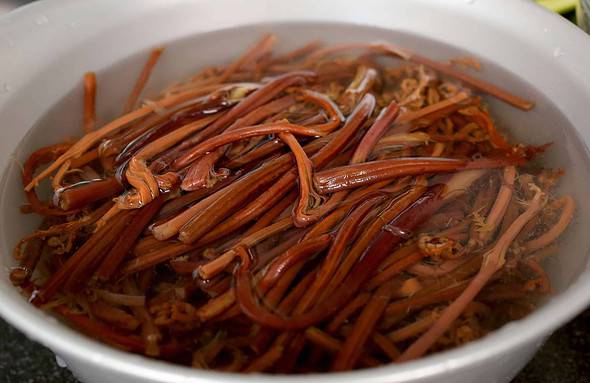
- Taste the gosari: It should be soft. If it’s tough, boil it again in a fresh pot of water for about 20 minutes and then let it sit, covered, until soft.
- Drain. It should make 4 ounces.
Make rice
If you have a usual method for making rice or have a rice cooker, go ahead and make 5 cups of rice like you usually do. But here’s how I do it on a pot on the stove. 2 cups of dried rice makes about 5 cups of cooked rice.
- Rinse 2 cups of rice in cold water and scrub the wet rice with your hand. Rinse and drain until the drained water is pretty clear.
- Put the rice in a heavy-bottomed pot. Add 2 cups of water, cover, and soak for 30 minutes.
- Cook over medium high heat for 7 to 8 minutes until the surface is covered with abundant bubbles that are spluttering noisily and look like they’re about to overflow the pot. Turn the rice over a few times with a spoon and cover the pot again.
- Turn the heat to very low and simmer for another 10 minutes until the rice is fully cooked and fluffy. Remove from the heat.
- Fluff the rice with a spoon to release excess steam. Let the rice stand, covered, at room temperature to keep it warm.
Prepare and cook the ingredients for bibimbap
I like to get a big platter and then put each vegetable on it as they’re ready. I think it looks really pretty, but you don’t have to do this. When all vegetables are prepared and ready to use, the platter looks pretty delicious!
Soybean sprouts:
- Put the soy bean sprouts in a pot and add 4 cups water and 2 or 3 teaspoons salt. Cover and cook for 20 minutes over medium high heat. Take out the sprouts with tongs and put them into a bowl, leaving about ½ cup of sprouts in the pot with the water you used to boil them. This is the soup to serve with bibimbap later.

- In a bowl, mix the sprouts by hand with ½ teaspoons salt, 1 teaspoon minced garlic, and 2 teaspoons toasted sesame oil. Put them on the large platter.
Spinach:
- Cut up the blanched spinach a few times and put it in a bowl. Mix by hand with 1 teaspoon garlic, 1 teaspoon toasted sesame oil, ½ teaspoon kosher salt, and 1 teaspoon sesame seeds. Cover and put it next to the soy bean sprouts on the platter.
Other fresh vegetables:
- Cut the carrot into matchsticks, put them in a bowl, and mix with a pinch of salt. Let stand for 5 to 10 minutes until sweating.

- Cut the red bell pepper into halves, deseed, and slice into strips. Put them in a bowl.
- Cut the zucchini into matchsticks and mix with ½ teaspoon kosher salt.
- Cut the cucumber into halves lengthwise and slice thinly crosswise. Mix with ¼ teaspoon kosher salt.
Beef:
- Cut the beef into matchsticks and put them in a bowl.
- Mix with 1 tablespoon minced garlic, 1 tablespoon soy sauce, 1 tablespoon honey, 2 teaspoons toasted sesame oil, and 1 teaspoon sesame seeds with a spoon.

- Cover and keep in the fridge until ready to use.
Mountain vegetables:
- Cut the fernbrake (gosari) a few times into bite size pieces. Set aside.
- Put the bellflower roots (doraji) in a large bowl. Add 1 or 2 tablespoons salt. Rub for a minute to wilt slightly and release some of the bitterness. Rinse them in cold water a couple of times and drain. If you find some roots are too thick, split them lengthwise. Set aside.
Let’s cook!
- Heat up a pan over medium high heat. Squeeze out excess water from the carrot. Add a few drops of cooking oil to the pan and sauté the carrot for 1 minute. Put it on the platter next to the soy bean sprouts and spinach. Clean the pan with wet paper towel or wash it.
- Heat a few drops of cooking oil in the pan and squeeze out the excess water from the cucumber. Sauté with ½ teaspoon minced garlic and a few drops of toasted sesame oil for 30 seconds. Put it on the platter. Clean the pan.
- Heat up the pan with a few drops of cooking oil. Add the red bell pepper and sprinkle a pinch of salt over top. Sauté for 30 seconds. Put it on the platter. Clean the pan.
- Heat up the pan and squeeze out excess water from the zucchini. Add a few drops of cooking oil and sauté with 1 teaspoon minced garlic, 1 tablespoon chopped green onion, a drop of toasted sesame oil for 1 minute until slightly softened. Put it on the platter. Clean the pan.
- Heat up the pan with a few drops of cooking oil. Add the bellflower roots and sauté for 2 to 3 minutes. Lower the heat to medium so as not to brown them. Add 1 teaspoon minced garlic and a drop of toasted sesame oil. Stir for another minute until a little softened. Put it on the platter. Clean the pan.

- Heat up the pan. Add a few drops of cooking oil. Stir the gosari for 2 minutes until a little softened. Add ½ teaspoon of minced garlic, 2 teaspoons soy sauce, and 2 teaspoons sugar, and keep stirring for another minute. Put it on the platter.
Serve
Here are a couple of ways to serve: bibimbap in a regular, shallow bowl, and dolsot-bibimbap in a stone or earthenware bowl.
In a regular, shallow bowl
- Reheat the soybean sprout soup.

- Divide the cooked rice into 4 portions. Each portion will be a little more than 1 cup of rice.
- Put the rice in each of 4 bowls and arrange the vegetables and beef on the rice. Top with a raw egg yolk and gochujang. If you prefer your eggs and beef cooked, use a fried egg sunny side up and slightly pan-fry the beef before putting them on the top of rice.
- Sprinkle the bibimbap with the sesame seeds and drizzle with sesame oil to taste.
- Ladle the soup to a small bowl and sprinkle some chopped green onion over top.
- Serve right away with more hot pepper paste on the side, and maybe kimchi too.

Dolsot-bibimbap in a hot earthenware bowl (ttukbaegi) or hot stone bowl (dolsot)
- Reheat the soybean sprout soup.
- Put a few drops of toasted sesame oil in the bottom of each of 4 earthenware bowls. They should be big enough to hold 4 to 6 cups each.
- Divide the rice among the bowls. Arrange the vegetables and beef on the rice. Top each serving with a raw egg yolk and 1 tablespoon gochujang. If you prefer your eggs and beef cooked, use a fried egg sunny side up and slightly pan-fry the beef before putting them on the top of rice.
- Set each pot on a burner. Heat over medium high heat until you hear a ticking, crackling sound coming from the rice.

- Sprinkle the bibimbap with the sesame seeds, drizzle with sesame oil to taste.
- Ladle the soup to a small bowl and sprinkle some chopped green onion over top.
- Serve right away with more hot pepper paste on the side and maybe kimchi too.

Eat
Maangchi's Amazon picks for this recipe
It's always best to buy Korean items at your local Korean grocery store, but I know that's not always possible so I chose these products on Amazon that are good quality. See more about how these items were chosen.



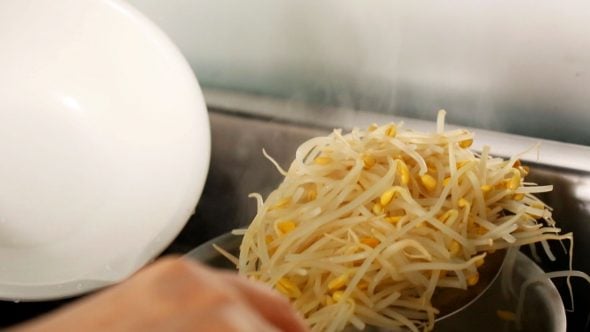
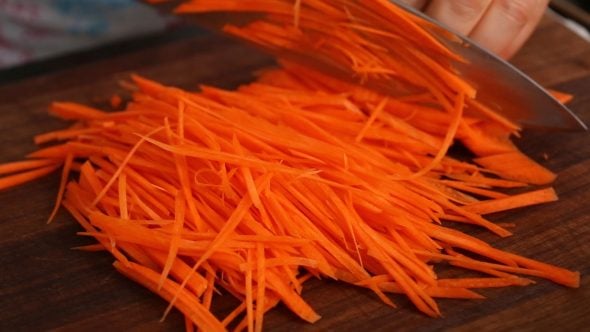
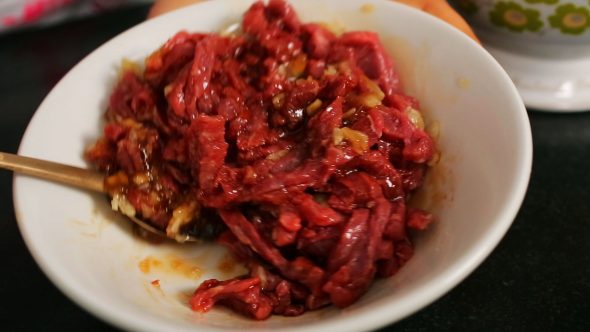
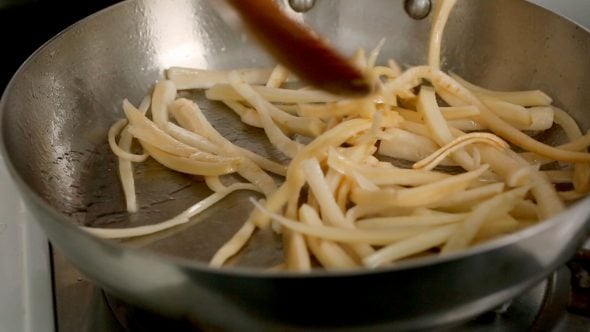
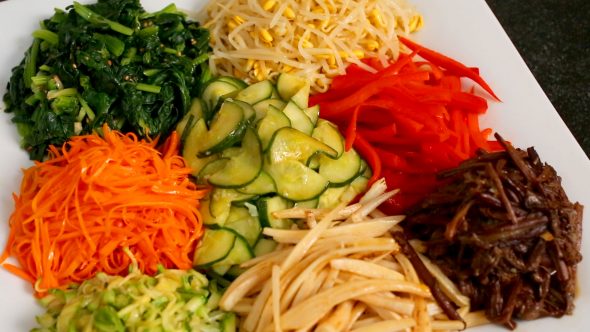
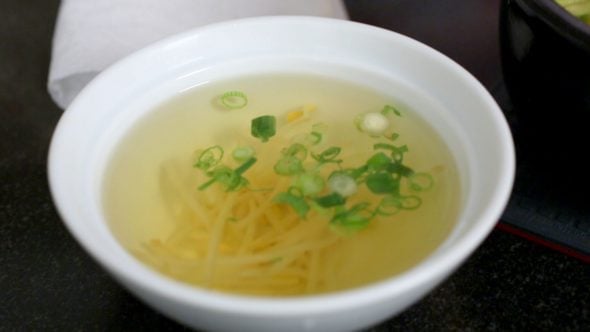
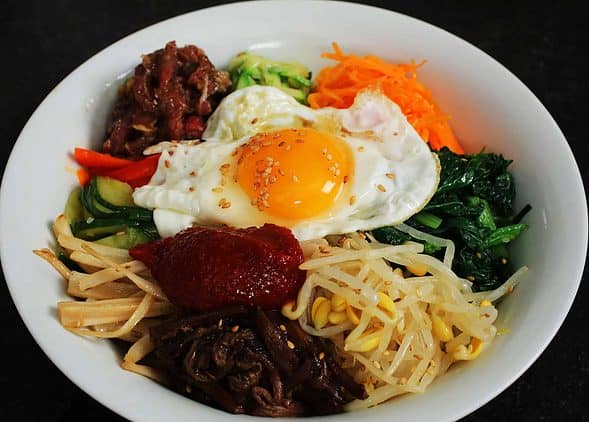

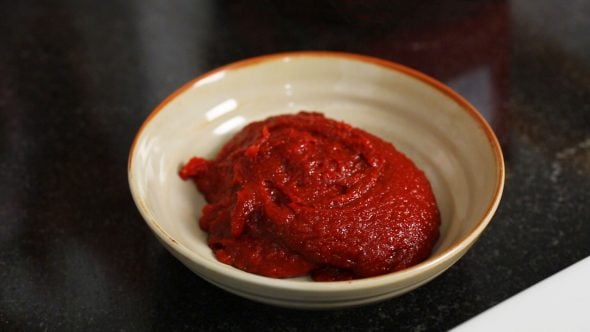
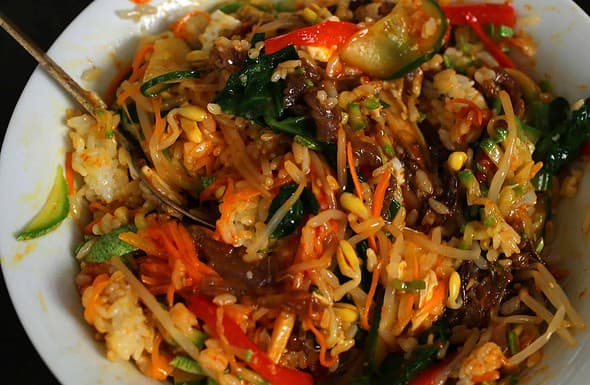






![[OTTOGI] Delicious COOKED RICE...](https://m.media-amazon.com/images/I/41zYdZ3EWJL._SL160_.jpg)


























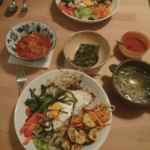

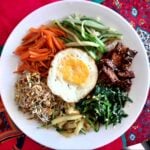
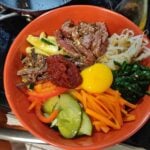
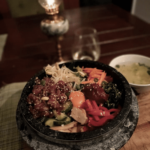
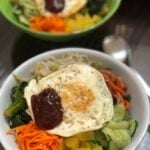



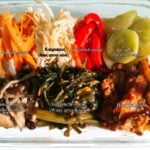
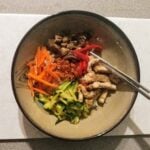
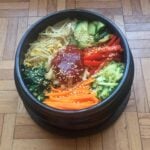



Hi Maangchi,
Can you tell me how to make the hot version? Dolsot bibimbap? I like the crispiness of the rice in the hot version and would appreciate it if you can just explain the extra couple of steps. Thanks!
Ji Hyun,
Your husband must be cool enough to make you decide to get married him at the age of 40! : )
I’m so happy to hear that you can use my recipes there.
Hi, I LOVE your website. I recently got married at the age of 40, and am now faced with the daunting task of cooking. Before, I was working and eating out all the time due to my busy schedule. I always found cooking to be difficult, especially Korean food, but you make it so fun and easy. I tried your Tang Su Yuk yesterday and I was just amazed at how good it tasted. My husband also agrees. I’m a Korean living abroad where there are no Korean grocery stores or restaurants so your recipes are just fantastic for me as I crave Korean food on an hourly basis! PS. I love your videos and you’re so sweet the way you explain everything!
Cathie,
Thank you for your interest in my recipes!
I think we have lots of things to talk about when it comes to Korean food and culture. : )
I have many excellent memories from Korea and am looking forward to a trip back there possibly next year. I was there in 1983. I have always loved it there. Our daughter is 23 and majored in Korean language in college. She is going to Korea to teach schoolchildren English for a year while she gets some immersion language experience. Anyway, I made the japchae today. It turned out fabulous and my husband loved it! I have made bulgogi and yakimandu for a long time and am so glad to have all of your wonderful teaching at my fingertips. Thanks again.
Linda,
Thank you very much!
Cathie,
oh, you must have a lot of good memories about Korea. Nice!
I was in Tongduchon, South Korean one summer with my husband and had many sweet ajima’s try to teach me how to cook the wonderful things they made. Since my days in South Korea, I have wanted someone to teach me more about Korean cooking. I am so happy to have found your website and am finding myself very successful ! Thank you very much.
This looks so good! I first found you on YouTube when I was looking for a recipe for job chae. I love this site. I can’t wait to try some of your recipes. You make them look so easy, but I know you put a lot of work and love into your food. Thank you, Maangchi
Umshik
oh, you are living in Seoul! Jeonju bibimbap is awesome. So many different kinds of vegetables and ingredients are used.
Bibimbob is my FAVOURITE korean dish! And, Maangchi, you would know how happy I was to have visited Jeonju and taste their bibimbob in one of those exquisite hanok houses. I have no problem finding the ingredients :-) Seoul has many!
Thank you for your response Maangchi. The fiddleheads I described are only available for a very short time in spring and are not widely distributed. We have something packaged called “dulce” in our markets which is a seaweed product. Might this substitute for the fern as far as texture and color?
Vivian,
Please say hello to David Lebovltz for me.
Yes, fiddleheads are kosari. I would like to join you to pick the fiddleheads in the spring! I love it! : )
http://en.wikipedia.org/wiki/Kosari
Hello Maangchi,
I am really thrilled to have found your website (referral on David Lebovitz blog today). I have always loved Bibimbap and will now try to make it at home. One question: I live in Canada and in spring we are able to get fresh “fiddleheads” from the east coast. They are the unfurled fronds of fern. Is this kosari?
Thanks for your devotion to teaching all of us the perparation of Korean cuisine.
meileng,
Thank you for your update! Wonderful!
Hi Maangchi, I’ve made bibimbap; everyone was very impressed by the dish presentation- and taste-wise! :) Here’re some pictures of the bibimbap I cooked:
http://www.meilengloh.com/?p=391
Thanks for the lovely recipe! :)
desy,
Did you read this page? I just copy and paste this
That’s a good idea of using dried kosari which is much cheaper than buying “soaked and cooked kosari”
Dried kosari
1. Place kosari in cold water in a
pot. 1 cup of kosari will need
more than 20 cups of water.
2. Boil it for 30 minutes and don’t drain hot water and let it soak. Wait about 6-8 hours.
I usually boil it at night and drain it next morning.
That’s it!
yes, you can replace beef with pork.
hi maangchi! I tried making bibimbab 2 weeks ago and it turns great! The only thing is the kosari is still hard to chew eventho i’d soaked it in hot water for a few hours. . Can I replace pork instead of using beef?
Yin and ashlee,
Bibimbap is good for university students? haha, whatever you say, I agree! Actually bibimbap is good for everybody. It’s a well balanced meal.
of course you can use chicken instead of beef.
Thank you!
hey can i use chicken instead of BEEF
Hey maangchi, I love your website. It’s so helpful.
I love Bibimbap, but i recently realised- it’s good food for a university student. and its easy to make too.
I use my rice cooker as a alternative for dolsot. =D
hi“bibimbap” , i love your video, and i also love bibimbap~ could u teach me how to make the bibimbap cook on stone? thank you
armie,
yes, “bibimbap” means mixed rice so you can mix rice with any kinds of ingredients you like. It could be vegetables or meat or the both. Give it a try!
thanks for the wonderful recipe…..
can i ask you few questions?
1. can i use a little bit of hot pepper oil when sauteing vegetables for bibimbap?
2. can i use NAGAIMO, DRIED BELLFLOWER ROOT, DRIED SWEET POTATO STEM, PEA SPROUT, OR LOTUS ROOTS in bibimbap? i went to korean supermarket and i saw these vegetables… i wonder if i can use them as vegetables in bibimbap.
THANKS……
Annyong Maangchi
I`m from Monterrey, Mexico and I love Korea and the Korean`s cousine.
Thanks for you videos…now I feel very good to make some of my favorites dishes.
We have in Monterrey 2 Korean`s restaurants.
Regards and
God bless you!!!
Atte
Damaris Salinas V.
Thank you. But it says, the video is no longer available. :(
Can you tell me how to do the spica\y sauce?
Hi,
You have a nice cooking blog, too! Your pork bulgogi looks good!
hi maangchi, i m glad to find your interesting blog. It is very helpful for me to cook Korean food. I can cook pork bulgogi and bibimbap. My husband Korean colleague taught me. I will try your recipes. Stir fry squid is next…
Hallo hallo Jenny,
It’s already posted! Check it out.
Hallo,
I love Bibimbap and I want to cook it. But it seems like I couldnt see your video. Can you let me know how to do the hot & spicy sauce?
Quyen,
I posted bibimbap video!
https://www.maangchi.com/recipe/bibimbap
Thank you for your interest in my recipes!
Hi Maangchi, how are you? Thank you for all the provided receipe. I’m in a desperate want to know how to make Korean foods. Thanks to you and your great receipes. However, I’d like to ask a favor; can you please show me how to make bibimbap through the video? I was trying to watch it online, unfortunately, it didn’t work. Can you please double check the network?
Thank you so much.
Sincerely,
Quyen.
Tetyana,
I am happy to hear about your success! Thank you!!
Maangchi,
Thank you for this recipe. I made it!!!!!!!! The taste was sooo authentic, just like we had this when we lived in Korea. My husband is absolutely happy now, and calls me wonder cook :). Thanks to you
Hua,
I think you will have to eat all leftover ingredients in 24 hours even though you keep it in the refrigerator.
Hi Maangchi!
How long can we keep the left over ingredients in the fridge before it goes bad?
I’m going to make this dish over the weekend.
Thanks,
Hua-